- This photo feature has a day-by-day account
of the exciting 4-day trek to Sandakphu in West Bengal.
Sandakphu
or Sandakpur (11,930 ft.) is a mountain peak in the Singalila Ridge on the
border between India and Nepal. It is the highest point of the ridge and of the
state of West Bengal.
It offers grand views of the world's tallest peaks - Mt Everest, Makalu (5th highest), Kanchenjunga (3rd), Lhotse (4th) and many other peaks of Nepal, Sikkim, Tibet and Bhutan.
The
Kanchenjunga cluster is famously called The Sleeping Buddha, thanks to its appearance.
Mt. Kumbhakarna forms the head and face of Buddha, while Mt. Kanchenjunga forms
the upper body. The other peaks that make up the rest of The Sleeping Buddha
are Kokthang, Rathong, Frey, Kabru South, Kabru North, Simvo, Mt. Pandim,
Tenzingkhang, Japanu and Narsing.
We
did the trek from March 21-24, 2024. Here is a day wise experience.
Day 1
We had reached Rimbick, a small town (approx. 5.5 hrs from the Bagdogra Airport) the previous day. We started our drive at 7 am. After a back breaking one-hour drive, we started our trek through the jungles. We began on a narrow trail inside the dense forest. Rhododendron flowers welcomed us from the very beginning. The Rhododendron is Nepal's national flower and is known locally as Lali Gurans.
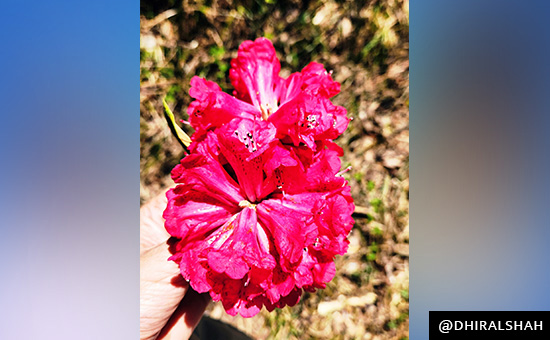
We
came across a beautiful twin pond, with a gazebo, a small bridge and decorated
with colourful flags. Our guide Sherpa showed us a very different kind of
fruit/nut. It was horse chestnut, called Bante
by the locals who use the extract as a medicine, and tasted like a chewy berry.
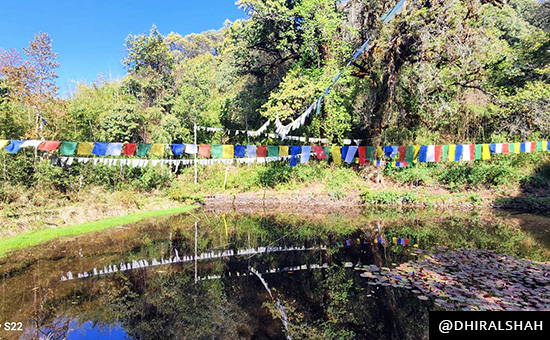
At
9.30 am we stopped for our packed breakfast (Alu sabzi, black chana subzi and
parathas). It was some experience having breakfast on the jungle floor.
Pine/Bamboo trees and the Rhododendrons covered our trail. So did tiny orange
coloured and black dotted beetles. We were all just embracing the serenity of
the woods.
March
and April are the Rhododendron flowering season months. Locals make
Rhododendron wine from the red Rhododendrons. In Uttarakhand, Rhododendron
juice is very popular. The fallen down flowers resembled a red carpet. The
forest was coloured red!!
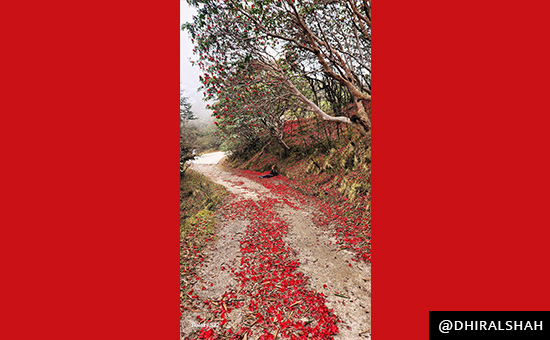 Fallen down Rhododendron
flowers.
Fallen down Rhododendron
flowers.
The
path got foggy as we went higher in altitude. We were literally walking in the
clouds. We could not even see 20 feet away. The 9 km ascend trail in the
jungles was challenging, but being surrounded by the greens, reduced the
fatigue. Our lunch stop was at Bikhay Bhanjyang. Sandakhpu was 3 km away. We
had ascended 5470 ft. in a day.
It
was cold and windy by the time we reached Sandakphu (11,930 feet). We stayed in
trekkers huts. There were a few rooms and a common toilet. We spent the
evening, in the common dining hall, sharing our experiences with other
trekkers.
It
had been very cloudy since we reached Sandakphu and thus had not seen the
Sleeping Buddha. The locals told us that the windier it is at night, the
clearer it might be at sunrise.
Day 2
We
reached sunrise point by 5 am. It was freezing cold and windy. The skies had
turned pretty peach, pink and light orange. We waited to see views of Sleeping
Buddha. The tip of the Sun emerged and slowly the skies turned orange. It was
mesmerising.
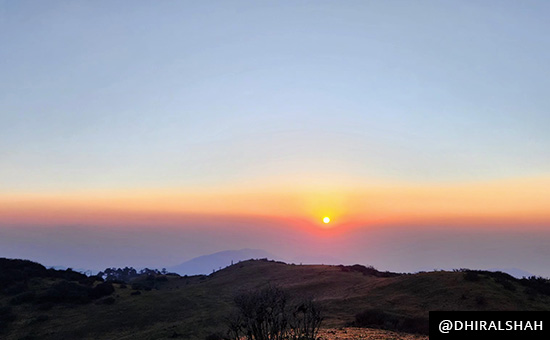
The Sleeping Buddha’s belly got the first rays of the Sun. Slowly the entire belly and face lit up. The entire Kanchenjunga range shone and the entire figure of the Sleeping Buddha was lit up.
 Sleeping Buddha.
Sleeping Buddha.
After
a quick breakfast, we started a 14 km trek to Sabargram (11575 ft.). It is
almost parallel to Sandakphu. The route included a little rocky road to begin
with. At some places the Sleeping Buddha seemed very close to us. It was over
whelming. It made me feel like a tiny speck on this mighty Earth. I was
completely in awe of this majestic mountain range. I feel gratitude for being
lucky enough to witness the best of nature.
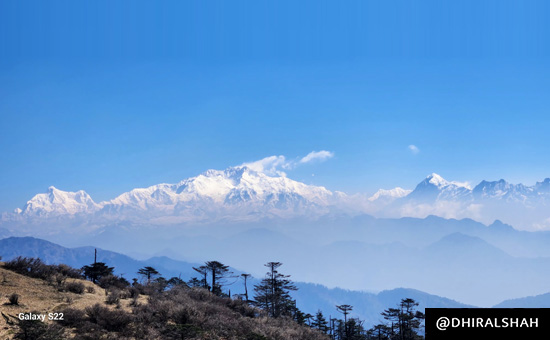
Our
trail continued on beautiful hillocks and never ending meadows with yaks
grazing. On one side of these mountains is India, and the other side is Nepal.
It is very easy to cross borders here.
After
around four hours and 7 km of ascending and descending these beautiful hillocks
we reached our lunch stop. A beautiful house on the top of a hillock at Thakum
Valley (11,145 ft).
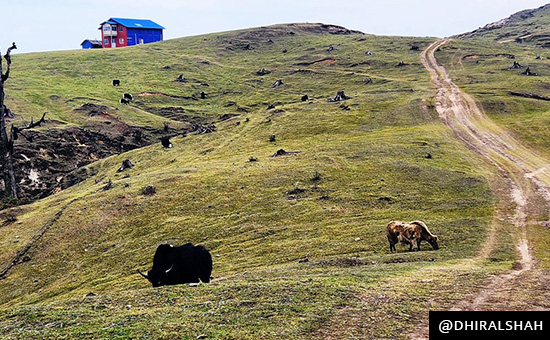
We
had another 7 km to hike over these beautiful grasslands to reach Sabargram.
This quaint little place in between hillocks had 1 trekkers hut with a total of
seven beds, a kitchen, a small dining table and a common toilet. Tents are
pitched for larger trekking groups.
They
have no running water supply. In the winters, they break ice and boil on gas to
get water. They have a very unique tap system. On a rod, there is a plastic
container with a hole in it. On that rod there is a bottle of liquid soap
attached for use. So a person needs to pour water into the plastic container
where the water will pour slowly from the hole and thus have their hands free
to wash.
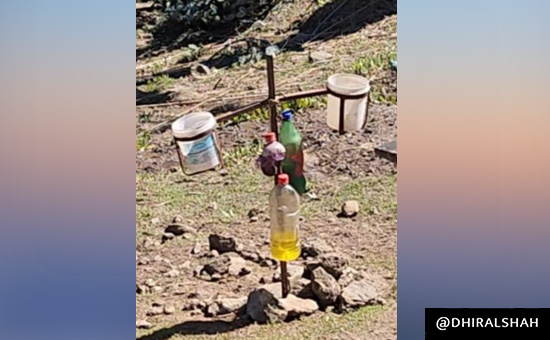
Day 3
We
got up at 5 am to experience the sunrise. After getting frozen on the hillock,
a dot of the Sun appeared. The next 4 minutes were magical, as the Sun showed
its full self, illuminating the Sleeping Buddha. The Kanchenjunga mountains
were standing tall and in full splendour. We could also spot Mt. Everest very
clearly.
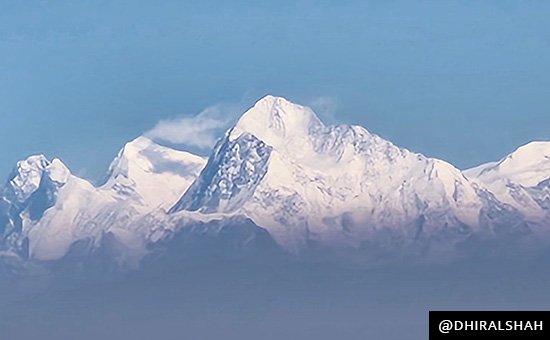 Mount Everest is in centre of three peaks, just below cloud.
Mount Everest is in centre of three peaks, just below cloud.
After
a quick breakfast we left for Rammam (7760 ft). We were going to descend 3815
ft. in the12 km trail.
The
trek downhill had numerous pine trees and bamboo plants. It was a thrilling
experience to explore the untamed beauty of the forest.

Not having network for two days made one feel in the moment. It’s just you and the gorgeous surroundings. This forges a deep connection between you and yourself. It is extremely satisfying to the soul. We were lost in the beauty of these jungles.
We
walked for 6.5 hrs through these beautiful trails to reach Rammam. The last 1
km to reach this picturesque village was a bit challenging as the path had big
rocks. But all was worth it when we entered this quaint village. We stayed at
Karma Homestay. A beautifully done up home with lots of flowers and plants.
We
got running water after two days, so it felt wonderful. Such basics of life are
also a luxury in these remote mountainous areas. These experiences are so
humbling. Inspite of living in big cities that have better infrastructure and
so much more, we are never at peace.
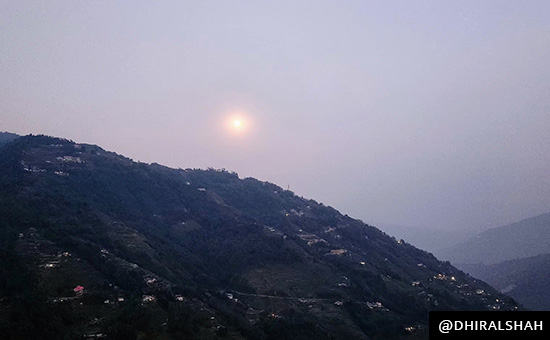 View of homes on a mountain opposite the Karma Home stay, on a full moon night.
View of homes on a mountain opposite the Karma Home stay, on a full moon night.
The
mountain on the other side was in Sikkim whilst we were in West Bengal. The
river Ramman separated the states of West Bengal and Sikkim. There are bridges
to cross the river.
We
tasted a delicious vegetable made from a local plant called ningro (in Nepalese) or limdi (in Himachal Pradesh) which was
made with some cheese. We also had the local Tongba beer. It is a millet-based alcoholic beverage found in the eastern mountainous region of Nepal, Bhutan, Sikkim and Darjeeling. They fill an Aluminium container with millet, wheat, herbs, some yeast and then fill it up with warm water. It’s allowed to rest for around 15-20 minutes, and then drunk with an aluminium straw. After it’s over, one can refill more warm water, let it rest and drink again. The locals treat it as a health drink. It tastes like a very different draught beer.
We
wrapped up the day early as the next day was a long trek through the Black
Forest Region. This entire place in the West Bengal side is called the
Singalala National Reserve. Black Forest Region is the part where the jungle
gets denser and has no human habitat.
Day 4
The
trail to our base village Rimbick was once again filled with Rhododendron
trees. It was a beautiful clear day with blue skies and white fluffy clouds-natures
artwork at its best. There were many streams and waterfalls from which we could
refill our water bottles. The entire trail was through the forests with
beautiful small villages popping up in between. All the houses in these
villages were brightly painted and decorated with beautiful flowering plants.
Huge beautiful dogs and the cutest babies seemed to be a thumb rule of every
house.
In
this region they have a very different way to store corn. They removed the
outside skin and hang it upside down in bunches in an open area. They said it
was a storage technique without the corn going bad. Every house also had some
sort of vegetation growing. They grew normally green peas, corn and potato in
rotation through the year. At this time, it was the season for green peas which
were very sweet. The locals also ate the skin of the green pea pod after
removing a part of it. There were wild strawberries growing on the ground which
tasted different from our regular strawberries.
Flowers
welcomed us everywhere, small white, pink and purple ones. The picturesque
trails with these pretty villages, mountains and clear blue skies made the
trail super invigorating.
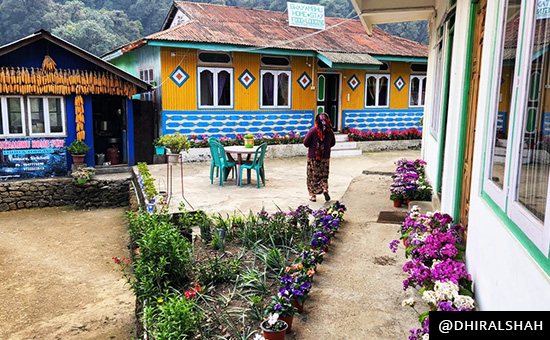
We
reached our lunch stop Syambhu Home Stay at Thimbure, Sirikhole at 1.30 pm. It
was an extremely steep descent through rocks. This tiny hamlet was completely
cut off from everything, right in between a valley. It was a gorgeous home stay
done up so well with a big dining hall and kitchen and many rooms for trekkers.
It had exotic flowering plants. They served us a wholesome meal with rice and 5
vegetables.
At
2.15 pm, we left for the Black Forest. We started with crossing a river on a
shaky bridge made with a few wooden planks. The guide had to put some huge
boulders on one of the ends to stop the wooden planks from shaking. Then we
climbed a straight 70 metres to get on to the forest path. We clawed our finger
nails and palms into the mud, holding on to roots and branches of a few plants
for support to climb. This was a perfect trekking experience.
We were finally in the Black Forest
region of the Singalila National Park.
It is
a dense forest. We could not see the sky in the beginning. The narrow path of
an ascending path with steps every few metres was covered with moss. I was
completely captivated by the allure of this woodland. I guess this is what a
jungle meant in kids story books, where the trees whisper stories of old. There
were times when I was walking all alone on the trail for a few 100 metres and
it felt eerie but magical. In the forest, I found peace and tranquillity.
We hardly met one or two people on this route. This was the oldest route used before 1984. We continued on this narrow path for the next 3.5 hrs.
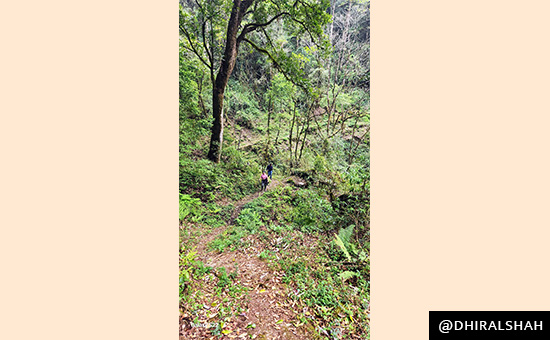
We were hoping to see the red panda, though we were told that it was not a possible to spot red pandas in this lower region. They are elusive animals. These trees or even the trees in the upper forest regions are so tall that even if a panda was sitting on the branches above, we would not be able to spot it. There were lot of bird sounds, but we couldn’t spot any. It was a long beautiful hike in the forest.
After
walking for 10.5 hrs and covering 16.5 km. we reached Rimbick. Walking past
this village took us back to another era. It was a clean, well-kept village
with nice roads and small shops. We reached our hotel at 6.30 pm. It was a long
day, but an enthralling visual treat that completely enriched the soul.
That
was the end to a fabulous trek.
Pictures
are courtesy and copyright author.
Also
read
1. Annapurna
Base Camp Trek
2. Goe-cha la Trek,
Sikkim
3. Karakoram
Maitri Expedition
4. Stok
Kangri Trek
5. Trek
to Sonmarg
6. Minkiani
Pass Trek
7. Pindari
Trek, Kumaon
8. Chadar
Trek Ladakh